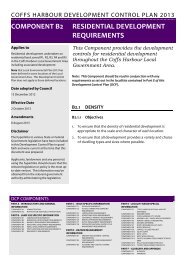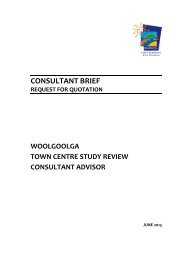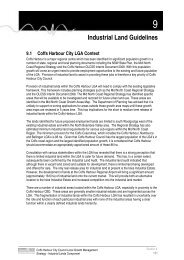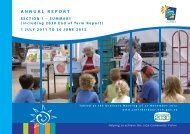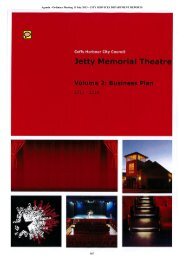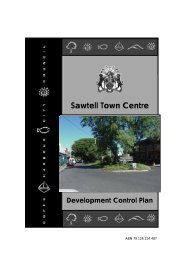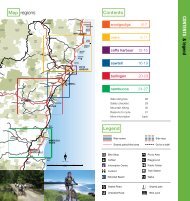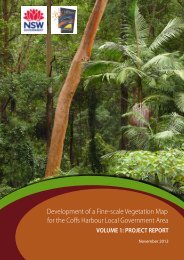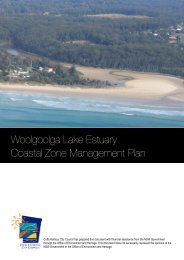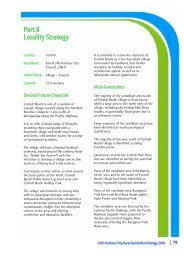Indian Myna Bird Pamphlet - Coffs Harbour City Council
Indian Myna Bird Pamphlet - Coffs Harbour City Council
Indian Myna Bird Pamphlet - Coffs Harbour City Council
Create successful ePaper yourself
Turn your PDF publications into a flip-book with our unique Google optimized e-Paper software.
What can we do<br />
Reduce available food source<br />
Want to Know More<br />
Call the Mid North Coast <strong>Indian</strong> <strong>Myna</strong><br />
Hotline for more information on the<br />
trapping program or to report sightings<br />
of large numbers of <strong>Myna</strong> birds.<br />
HOTLINE<br />
0438 218 261<br />
Email:<br />
indianmyna_midnorthcoast@yahoo.com.au<br />
Website:<br />
• Refrain from feeding birds, particularly with bird seed<br />
• Do not leave uneaten pet food outside, feed pets<br />
indoors where possible<br />
• Do not leave food scraps in picnic areas, school<br />
grounds or at sporting ovals<br />
• Prevent access to poultry and stock feed<br />
Reduce avaliable habitat<br />
HELP<br />
INDIAN MYNAS<br />
CONTROL<br />
THE<br />
INVASION<br />
Free stickers available<br />
• Block holes in roofs and eaves, to stop <strong>Indian</strong><br />
<strong>Myna</strong>s nesting.<br />
• Plant native shrubs to reduce open areas in gardens.<br />
Avoid exotic tree species commonly used as roosts<br />
eg. pines and palms<br />
• Find and destroy nests<br />
Trapping program<br />
• A local trapping program in the Nambucca, <strong>Coffs</strong> and<br />
Bellingen Local Government Areas is currently underway<br />
using specialised traps to humanely catch <strong>Indian</strong> <strong>Myna</strong>s.<br />
• Contact your <strong>Indian</strong> <strong>Myna</strong> Project Officer to borrow a<br />
trap and for assistance in trapping. Information will<br />
also be provided on how to humanely euthanase<br />
trapped birds.<br />
• Traps are simple and cheap to make. Visit our website<br />
to view the recommended PeeGee trap design.<br />
Funded by the NSW Environmental Trust<br />
and supported by the following organisations:<br />
BELLINGEN SHIRE COUNCIL<br />
LANDCARE<br />
NAMBUCCA VALLEY<br />
Developed by the Mid North Coast <strong>Indian</strong> <strong>Myna</strong> Project.<br />
Designed by MIRA Design Studio. Printed on Envirocare recycled paper.<br />
<strong>Indian</strong> <strong>Myna</strong><br />
Managing the invasion of <strong>Indian</strong><br />
<strong>Myna</strong>s on the NSW Mid North Coast
Managing the invasion of <strong>Indian</strong> <strong>Myna</strong>s<br />
<strong>Indian</strong> <strong>Myna</strong>s are listed as<br />
“One of the World’s 100<br />
Most Invasive Species”<br />
(World Conservation Union)<br />
<strong>Indian</strong> <strong>Myna</strong> Profile<br />
The <strong>Indian</strong> <strong>Myna</strong> (Acridotheres tristus) was introduced<br />
to Australia from southern Asia in the late 1860’s and<br />
rapidly established along the eastern coast of Australia.<br />
In recent years their distribution has spread to other parts<br />
of the country including Darwin, Perth and Adelaide. <strong>Indian</strong><br />
<strong>Myna</strong> birds are commonly found in urban environments<br />
and in agricultural areas near bales and dairy sheds.<br />
They favour open grassy areas, rarely venturing into<br />
closed canopy forests.<br />
<strong>Indian</strong> <strong>Myna</strong>s are scavengers, able to utilise a wide<br />
range of food types including insects, fruits, vegetables,<br />
pet food and stock feed. At night they gather to sleep in<br />
communal roosts under bridges, in large dense trees<br />
or empty buildings.<br />
<strong>Indian</strong> <strong>Myna</strong> (Acridotheres tristus)<br />
Introduced pest<br />
Black head<br />
Chocolate<br />
brown body<br />
Yellow beak<br />
& eye patch<br />
White wing patch<br />
(visible when flying)<br />
Long yellow legs<br />
What do they<br />
look like<br />
The <strong>Indian</strong> <strong>Myna</strong> is a<br />
chocolate brown bird,<br />
about 12cm tall. It<br />
has a yellow beak, eye<br />
patch and legs. White<br />
wing patches are also<br />
obvious when birds are flying.<br />
Not to be confused with<br />
the Native Noisy Miner<br />
The native Noisy Miner (Manorina melanocephala) is<br />
sometimes mistaken for the <strong>Indian</strong> <strong>Myna</strong>. The Noisy Miner<br />
also has a yellow beak and eye patch, but has flesh coloured<br />
legs. The key difference between the two birds is that the<br />
<strong>Indian</strong> <strong>Myna</strong> has a brown body, whilst the Noisy Miner is<br />
mottled grey and white.<br />
Why are they a problem<br />
• Nests block spouting on roofs, often causing<br />
water damage to buildings.<br />
• Extremely aggressive, competing with native<br />
wildlife for scarce resources, eg. rosellas for<br />
tree hollows<br />
• Carrier of bird mite and<br />
other diseases<br />
• Reduced aesthetics due to<br />
noise and fouling around<br />
roosting/nesting sites<br />
• Agricultural pest,<br />
exploiting stock feed and<br />
causing damage to fruit<br />
and grain crops.<br />
Black patch<br />
around eyes<br />
Yellow beak<br />
& eye patch<br />
Pale grey breast<br />
& white belly<br />
Flesh coloured legs<br />
noisy miner (Manorina melanocephala)<br />
Native bird<br />
Olive tinge<br />
near wing edge<br />
The Noisy Miner is<br />
a honeyeater and has<br />
a much more limited<br />
diet. It prefers to forage<br />
for nectar and sap<br />
sucking insects.



